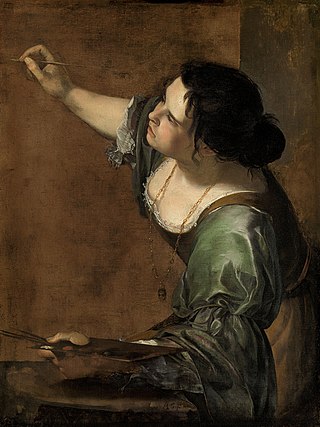
Artemisia Lomi or Artemisia Gentileschi was an Italian Baroque painter. Gentileschi is considered among the most accomplished seventeenth-century artists, initially working in the style of Caravaggio. She was producing professional work by the age of 15. In an era when women had few opportunities to pursue artistic training or work as professional artists, Gentileschi was the first woman to become a member of the Accademia di Arte del Disegno in Florence and she had an international clientele.

Massimo Stanzione was an Italian Baroque painter, mainly active in Naples, where he and his rival Jusepe de Ribera dominated the painting scene for several decades. He was primarily a painter of altarpieces, working in both oils and fresco. His main subject matter was biblical scenes. He also painted portraits and mythological subjects. He had many pupils and followers as his rich color and idealized naturalism had a large influence on other local artists, such as Francesco Solimena. In 1621 Pope Gregory XV gave him the title of Knight of the Golden Spur and Pope Urban VIII made him a knight of St. John around 1624 and a knight of the Order of Christ in 1627. From then on, he liked to sign his works as "EQUES MAXIMUS".

David with the Head of Goliath is a painting by Italian Baroque artist Massimo Stanzione, created c. 1642–1643. It is now in the San Diego Museum of Art.

Venus and Cupid (Sleeping Venus) is a circa 1626 painting by Artemisia Gentileschi in the Virginia Museum of Fine Arts. Venus and Cupid is a depiction of a sleeping Venus, who reclines on a blue bed covering and rich crimson and gold tasseled pillow. She wears nothing except a thin wisp of transparent linen around her thigh. Her son Cupid fans her with richly colored peacock feathers as she drifts to sleep. He is gazing at her with an adored, raptured expression. In the background, there is a window looking out onto a moonlight landscape where a temple to the goddess lies. Venus's face has full cheeks, heavy lids, a prominent nose, and small protruding chin—all features of Gentileschi's own face. The body movements are natural: Venus's hand rests lightly on her side, her legs are gently laid together. The work blends together realism and classicism through its iconography and the artist's style.

Judith and her Maidservant is a c. 1615 painting by the Italian baroque artist Artemisia Gentileschi. The painting depicts Judith and her maidservant leaving the scene where they have just beheaded general Holofernes, whose head is in the basket carried by the maidservant. It hangs in the Pitti Palace, Florence.
This is an ongoing bibliography of work related to the Italian baroque painter Artemisia Gentileschi.
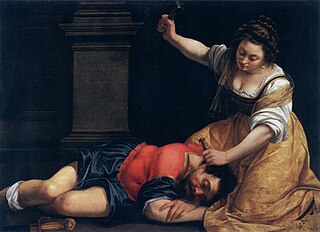
Jael and Sisera is a painting by the Italian Baroque artist Artemisia Gentileschi, executed around 1620.

Santa Cecilia is an early painting, from c. 1620, by the Baroque painter Artemisia Gentileschi, a painter described as "a grand exception in the history of art - a successful woman painter in an era in which art was dominated by men."

The Portrait of a Nun is a painting from the 1610s, attributed to the Italian artist Artemisia Gentileschi. It is currently in a private collection
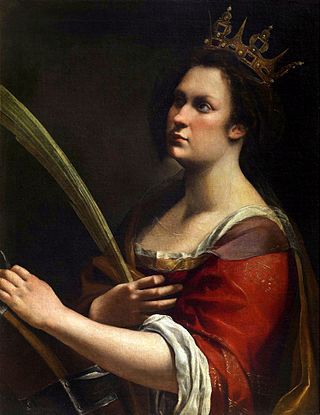
Saint Catherine of Alexandra is a painting by the Italian Baroque artist Artemisia Gentileschi. It is in the collection of the Uffizi, Florence. Gentileschi likely used the same cartoon or preparatory drawing to create both this painting and the Self-Portrait as Saint Catherine of Alexandria (1615–1617), now in the National Gallery, London.

The Allegory of Painting is an painting from around the 1640s attributed in 1988 to the Italian Baroque artist Artemisia Gentileschi, although more recent research suggests it was painted by an anonymous Neapolitan painter in the mid-17th century. It is now in the Musee de Tesse, Le Mans, France.

The Portrait of a Gonfaloniere is a painting by the Italian baroque artist Artemisia Gentileschi. It hangs in the Palazzo d'Accursio, Bologna. It is a portrait of an unknown gonfaloniere standing in full regalia and was painted in 1622. Mary D. Garrard has speculated that the man may be Pietro Gentile of Genoa.
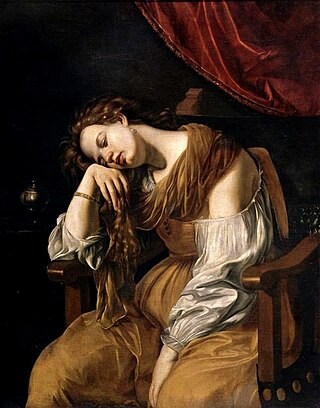
Penitent Magdalene is a painting by the Italian artist Artemisia Gentileschi. It hangs in Seville Cathedral. It has probably been in the cathedral since the late 17th century. She returned to the subject later in the 1620s in Mary Magdalene as Melancholy.
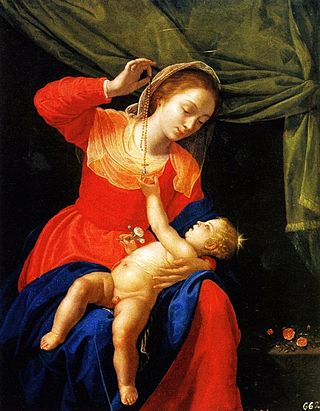
Virgin and Child with a Rosary is one of the last known paintings by the Italian artist Artemisia Gentileschi. Small in size and painted with oil on copper, it was completed in 1651. It was part of the Spanish royal collection and currently hangs in the El Escorial collection, in Spain.

The Self Portrait of Italian baroque artist Artemisia Gentileschi was painted in the early 1630s. It currently hangs in the Palazzo Barberini, Rome. It is one of many paintings where Gentileschi depicts herself. Beyond self-portraits, her allegorical and religious paintings often featured herself in different guises.
Allegory of Inclination is a 1615-1617 oil on canvas painting by Artemisia Gentileschi on the ceiling of the Galleria in the Casa Buonarroti, in Florence. The painting depicts a young nude female seated in the heavens holding a compass. Her light-colored hair is elaborately styled and she is partially covered by swirling drapery. A star appears above her head.

Saint Januarius in the Amphitheatre at Pozzuoli is a 1635-1637 oil on canvas painting by Artemisia Gentileschi. The work shows the moment that the Christian martyr Januarius and his followers are thrown to a group of wild animals in the amphitheatre in Pozzuoli - however, they lick the saint's feet rather than attacking him and Januarius is unharmed.

The Finding of Moses is an early 1630s painting by Orazio Gentileschi. There are two versions, the prime version is in The National Gallery in London and the second is in Museo del Prado in Madrid.

Bathsheba is a 1636-37 painting by the Baroque painter Artemisia Gentileschi, with contributions by Viviano Codazzi and Domenico Gargiulo. It shows the Hittite woman Bathsheba being washed and tended to by her servants. At the top left of the painting, King David sees her from his palace. It was one of seven versions from the story of Bathsheba that Gentileschi painted.

















